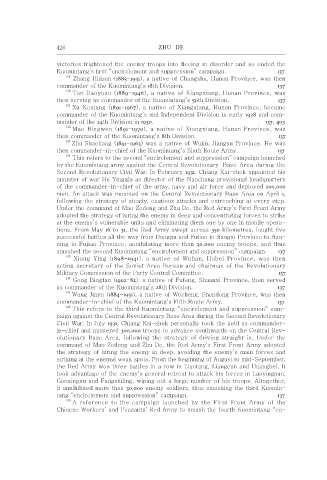Page 430 - SELECTED WORKS OF ZHU DE
P. 430
426 ZHU DE
victories frightened the enemy troops into fleeing in disorder and so ended the
Kuomintang’s first “encirclement and suppression” campaign. 137
139
Zhang Huizan (1885-1931), a native of Changsha, Hunan Province, was then
commander of the Kuomintang’s 18th Division. 137
140 Tan Daoyuan (1889-1946), a native of Xiangxiang, Hunan Province, was
then serving as commander of the Kuomintang’s 50th Division. 137
141
Xu Kexiang (1891-1967), a native of Xiangxiang, Hunan Province, became
commander of the Kuomintang’s 2nd Independent Division in early 1928 and com-
mander of the 24th Division in 1930. 137, 403
142
Mao Bingwen (1891-1970), a native of Xiangxiang, Hunan Province, was
then commander of the Kuomintang’s 8th Division. 137
143
Zhu Shaoliang (1891-1963) was a native of Wujin, Jiangsu Province. He was
then commander-in-chief of the Kuomintang’s Sixth Route Army. 137
144 This refers to the second “encirclement and suppression” campaign launched
by the Kuomintang army against the Central Revolutionary Base Area during the
Second Revolutionary Civil War. In February 1931, Chiang Kai-shek appointed his
minister of war He Yingqin as director of the Nanchang provisional headquarters
of the commander-in-chief of the army, navy and air force and deployed 200,000
men. An attack was mounted on the Central Revolutionary Base Area on April 1,
following the strategy of steady, cautious attacks and entrenching at every step.
Under the command of Mao Zedong and Zhu De, the Red Army’s First Front Army
adopted the strategy of luring the enemy in deep and concentrating forces to strike
at the enemy’s vulnerable units and eliminating them one by one in mobile opera-
tions. From May 16 to 31, the Red Army swept across 350 kilometres, fought five
successful battles all the way from Donggu and Futian in Jiangxi Province to Jian-
ning in Fujian Province, annihilating more than 30,000 enemy troops, and thus
smashed the second Kuomintang “encirclement and suppression” campaign. 137
145 Xiang Ying (1898-1941), a native of Wuhan, Hubei Province, was then
acting secretary of the Soviet Area Bureau and chairman of the Revolutionary
Military Commission of the Party Central Committee. 137
146 Gong Bingfan (1902-82), a native of Fufeng, Shaanxi Province, then served
as commander of the Kuomintang’s 28th Division. 137
147
Wang Jinyu (1884-1951), a native of Wucheng, Shandong Province, was then
commander-in-chief of the Kuomintang’s Fifth Route Army. 137
148
This refers to the third Kuomintang “encirclement and suppression” cam-
paign against the Central Revolutionary Base Area during the Second Revolutionary
Civil War. In July 1931, Chiang Kai-shek personally took the field as commander-
in-chief and mustered 300,000 troops to advance southwards on the Central Rev-
olutionary Base Area, following the strategy of driving straight in. Under the
command of Mao Zedong and Zhu De, the Red Army’s First Front Army adopted
the strategy of luring the enemy in deep, avoiding the enemy’s main forces and
striking at the enemy’s weak spots. From the beginning of August to mid-September,
the Red Army won three battles in a row in Liantang, Liangcun and Huangbei. It
took advantage of the enemy’s general retreat to attack his forces in Laoyingpan,
Gaoxingxu and Fangshiling, wiping out a large number of his troops. Altogether,
it annihilated more than 30,000 enemy soldiers, thus smashing the third Kuomin-
tang “encirclement and suppression” campaign. 137
149 A reference to the campaign launched by the First Front Army of the
Chinese Workers’ and Peasants’ Red Army to smash the fourth Kuomintang “en-

